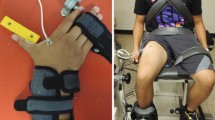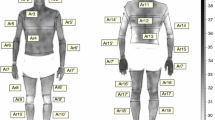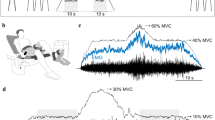Summary
The effect of dynamic cycle ergometer exercise and isometric leg exercise on skin sensitivity was studied in man. Exercise was performed at different loads. Cutaneous sensitivity to innocuous and noxious thermal stimuli was tested using a contact thermostimulator and sensitivity to tactile stimuli was tested using electrical stimuli. During isometric exercise a segmental (the exercising limb), but not a multisegmental, phasic decrease of cutaneous thermal sensitivity to innocuous stimuli was found. At the isometric forces used the effect on tactile and heat pain sensitivity was not significant. During dynamic exercise a multisegmental, load-dependent decrease of sensitivity in all tested sensory modalities was found and this attenuation disappeared gradually after the end of exercise. In contrast to isometric exercise, the decrease of sensitivity produced by dynamic exercise was most evident in tactile sensitivity. The size of the stimulus area (7.9 vs 11.8 cm2) did not have a significant effect on the magnitude of the exercise-induced decrease of cutaneous thermal sensitivity to innocuous stimuli. It was concluded that underlying the modulation of skin sensitivity by dynamic and isometric exercise were mechanisms that were different, at least to a small extent. Isometric exercise produced a segmental modulation of skin sensitivity due to central neuronal mechanisms, independent of exercise-induced stress. Exercise-induced stress could have caused the modulation of skin sensitivity by dynamic exercise.
Similar content being viewed by others
References
Angel RW, Weinrich M, Siegler D (1985) Gating of somatosensory perception following movement. Exp Neurol 90:395–400
Bushnell MC, Duncan GH, Dubner R, Jones RL, Maixner W (1985) Attentional influences on noxious and innocuous cutaneous heat detection in humans and monkeys. J Neurosci 5:1103–1110
Casey KL, Morrow TJ (1985) Arousal-related changes in the response of ventral posterior thalamic neurons to somatic and spinothalamic stimulation in the awake monkey. Adv Pain Res Ther 9:285–294
Chapin JK, Woodward DJ (1981) Modulation of sensory responsiveness of single somatosensory cortical cells during movement and arousal behaviors. Exp Neurol 72:164–178
Chapman CE, Bushnell MC, Miron D, Duncan GH, Lund JP (1987) Sensory perception during movement in man. Exp Brain Res 68:516–524
Chapman CE, Jiang W, Lamarre Y (1988) Modulation of lemniscal input during conditioned arm movements in the monkey. Exp Brain Res 72:316–334
Coquery JM (1978) Role of active movement in control of afferent input from skin in cat and man. In: Gordon G (ed) Active touch. Pergamon Press, Oxford, pp 161–169
Croze S, Duclaux R, Russek M (1977) Constancy of heat pain characteristics to changes in skin and body temperature. Brain Res 131:367–372
Dyhre-Poulsen P (1978) Perception of tactile stimuli before ballistic and during tracking movements. In: Gordon G (ed) Active Touch. Pergamon Press, Oxford, pp 171–176
Feine JS, Chapman CE, Lund JP, Duncan G, Bushnell MC (1990) The perception of painful and nonpainful stimuli during voluntary motor activity in man. Somatosens Mot Res 7:113–124
Fruhstorfer H, Lindblom U, Schmidt WG (1976) Method for quantitative estimation of thermal thresholds in patients. J Neurol Neurosurg Psychiatr 39:1071–1075
Ghez C, Pisa M (1972) Inhibition of afferent transmission in cuneate nucleus during voluntary movement in the cat. Brain Res 40:145–151
Gray BG, Dostrovsky JO (1984) Red nucleus modulation of somatosensory responses of cat spinal cord dorsal horn neurons. Brain Res 311:171–175
Hayes RL, Dubner R, Hoffman DS (1981) Neuronal activity in medullary dorsal horn of awake monkeys trained in a thermal discrimination task 11. Behavioral modulation of responses to thermal and mechanical stimuli. J Neurophysiol 46:428–443
Hellon RF, Mitchell D (1975) Convergence in a thermal afferent pathway in the rat. J Physiol (Lond) 248:359–376
Janal MN, Colt EW, Clark WC, Glusman M (1984) Pain sensitivity, mood and plasma endocrine levels in man following longdistance running: effects of naloxone. Pain 19:13–25
Jiang W, Lamarre Y, Parent MT, Marchand S, Chapman CE (1987) Modulation of somatosensory input to sensory cortex during isotonic and isometric limb movements in the monkey (Abstr). Soc Neurosci 13:673
Kemppainen P, Pertovaara A, Huopaniemi T, Johansson G, Karonen SL (1985) Modification of dental pain and cutaneous thermal sensitivity by physical exercise in man. Brain Res 360:33–40
Kemppainen P, Pertovaara A, Huopaniemi T, Johansson G (1986) Elevation of dental pain threshold induced in man by physical exercise is not reversed by cyproheptadine-mediated suppression of growth hormone release. Neurosci Lett 70:388–392
Kemppainen P, Paalasmaa P, Pertovaara A, Alila A, Johansson G (1990) Dexamethasone attenuates exercise-induced dental analgesia in man. Brain Res 519:329–332
Kojo I, Pertovaara A (1987) The effects of stimulus area and adaptation temperature on human heat pain and warm thresholds. Int J Neurosci 32:875–880
Lewis JW, Terman GW, Shavit Y, Nelson LR, Liebeskind JC (1984) Neural, neurochemical, and hormonal bases of stressinduced analgesia. Adv Pain Res Ther 6:277–288
Milne RJ, Aniss AM, Kay NE, Gandevia SC (1988) Reduction in perceived intensity of cutaneous stimuli during movement: a quantitative study. Exp Brain Res 70:569–576
Olausson B, Eriksson E, Ellmarker L, Rydenhag B, Shyu BC, Andersson SA (1986) Effects of naloxone on dental pain threshold following muscle exercise and low frequency transcutaneous nerve stimulation: a comparative study in man. Acta Physiol Scand 126:299–305
Pertovaara A, Huopaniemi T, Virtanen A, Johansson G (1984) The influence of exercise on dental pain thresholds and the release of stress hormones. Physiol Behav 33:923–926
Rozsa AJ, Molinari HH, Greenspan JD, Kenshalo DR (1985) The primate as a model for the human temperature-sensing system. 1. Adapting temperature and intensity of thermal stimuli. Somatosens Res 2:303–314
Rushton DN, Rothwell JC, Craggs MD (1981) Gating of somatosensory evoked potentials during different kinds of movement in man. Brain 104:465–491
Shin HC, Chapin JK (1989) Mapping the effects of motor cortex stimulation on single neurons in the rat: direct responses and afferent modulation. Brain Res Bull 22:245–252
Shyu BC, Andersson SA, Thoren P (1982) Endorphin mediated increase in pain threshold induced by long-lasting exercise in rats. Life Sci 30:833–840
Walthuis RA, Froehlicher VF, Fischer J, Triclermasser JH (1971) The response of healthy men to treadmill exercise. Circulation 55:153–163
Author information
Authors and Affiliations
Rights and permissions
About this article
Cite this article
Paalasmaa, P., Kemppainen, P. & Pertovaara, A. Modulation of skin sensitivity by dynamic and isometric exercise in man. Europ. J. Appl. Physiol. 62, 279–285 (1991). https://doi.org/10.1007/BF00571553
Accepted:
Issue Date:
DOI: https://doi.org/10.1007/BF00571553




